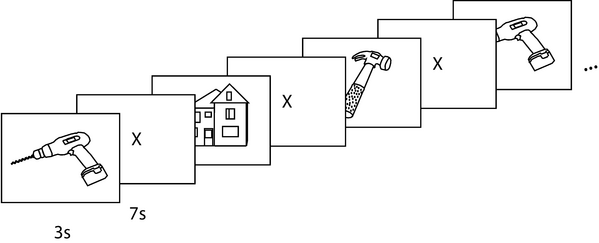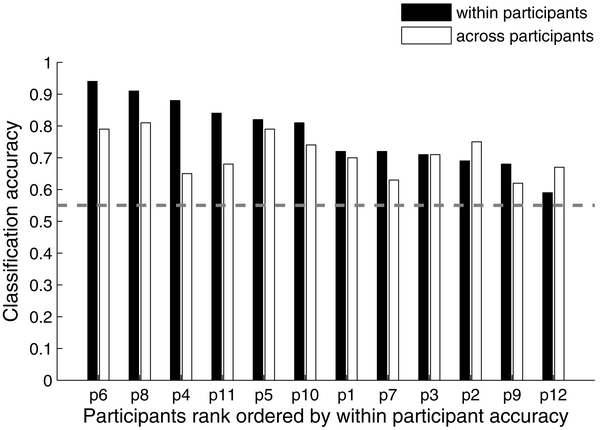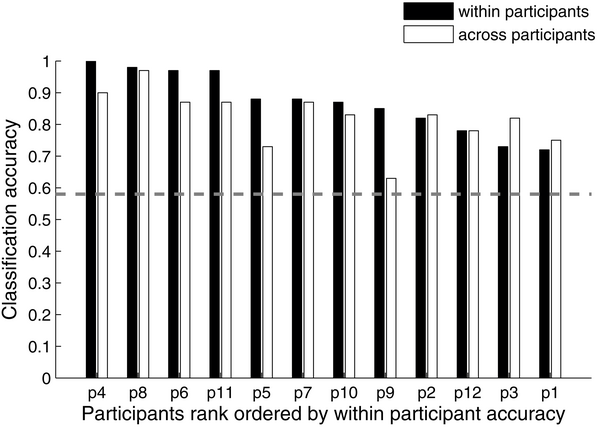

Thinking as a Hobby
3478561 Curiosities served
Computers Know What You're Thinking: An fMRI Study of Common Neural Activation
Previous Entry :: Next Entry
Read/Post Comments (1)
That's the subject of Shinkareva et al.'s study Using fMRI Brain Activation to Identify Cognitive States Associated with Perception of Tools and Dwellings (the full text is freely available on-line if you want to read it for yourself).
First of all, fMRI stands for "functional magnetic resonance imaging". What they're basically measuring is the flow of blood to different areas of the brain. Brain areas using more blood are more active, so this is an indirect measure of neural activity, and isn't nearly as fine-grained as electrophysiological measurements, but it can still tell us quite a bit about what's going on.
So here's what they did:
Twelve subjects had their brains imaged with fMRI while they looked at a series of line drawings. The stimuli included five instances of two categories, for a total of 10 images. The categories and exemplars were:
Category: Tools
drill
hammer
screwdriver
pliers
saw
Category: Dwellings
apartment
castle
house
hut
igloo
The drawings were presented in random order for 3 seconds each, with 7 seconds of fixation on an X between each presentation, and occasional 21 second intervals used to measure baseline activation. Here's a figure with examples of the drawings and the time course of presentation:

Subjects were instructed to "generate a set of properties for each exemplar." They give the example of "cold, stone, and knight for castle," which seems a little strange to me (I don't necessarily associate castles with cold...stone seems okay, but drawbridges, moats, and parapets seem more like features of castles).
Anyway, they took all the data and then trained a machine learning algorithm (a Gaussian Naive Bayes pooled variance classifier...no, I hadn't heard of it either) to identify which object (out of the 10) a subject was thinking about when presented with the fMRI data and in another case which class (TOOL or DWELLING). To do this, they trained the algorithm on the data from 11 of the subjects, then tested how well it predicted the results from the 12th (and they did this iteratively, so that all twelve subjects' data would be used as the test data).
Here's are the results for accurate identification of the particular object:

So just looking at the first subject (p6), what this means is that the algorithm trained to determine which object that subject was looking at when given their fMRI data was around 94% between presentations to the same subject (remember, they saw each object more than once), and a little under 80% compared to the data from the other 11 subjects.
And here are the results from the algorithm trying to tell which class of objects (either TOOLS or DWELLINGS) the subjects were looking at:

One interesting thing to note is that in both sets of results, there are cases where the identification accuracy is greater between subject than within subjects. That means that in those subjects, their brain activity was more like the other subjects when they were looking at the same object (or class) than when that subject looked at the object on different occasions.
They also trained the algorithm with data from single brain regions and from multiple brain regions, and though I don't really want to go into that, apparently the algorithm still performed reasonably well with data from a single region.
So are we nearing a point where a computer will be able to tell what you're thinking about by scanning the blood flow in your brain? I don't think so. That particular concepts activate common areas of the brain is interesting, though as they authors point out, the area of the motor cortex associated with hand actions such as grasping is likely to be active when thinking about tools such as hammers. They asked participants to explicitly think about features (though the example they gave sounds more like associated concepts). I wonder how differently the data might have looked if they were not given these instructions. They conclude that the representation for a concept like hammer is widely distributed, but the distribution may be a result of multiple concepts being simultaneously activated.
And again, blood flow is relatively coarse data, though it seemed to be sufficiently fine-grained to make very good predictions both within and between subjects.
I'm actually not sure what kinds of conclusions to draw about this study, though it's definitely interesting. It's another piece in the puzzle of how concepts are represented in the brain, though I wouldn't start worrying about shielding your head from the CIA just yet.
Shinkareva, S.V., Mason, R.A., Malave, V.L., Wang, W., Mitchell, T.M., Just, M.A., Sporns, O. (2008). Using fMRI Brain Activation to Identify Cognitive States Associated with Perception of Tools and Dwellings. PLoS ONE, 3(1), e1394. DOI: 10.1371/journal.pone.0001394
Read/Post Comments (1)
Previous Entry :: Next Entry
Back to Top

